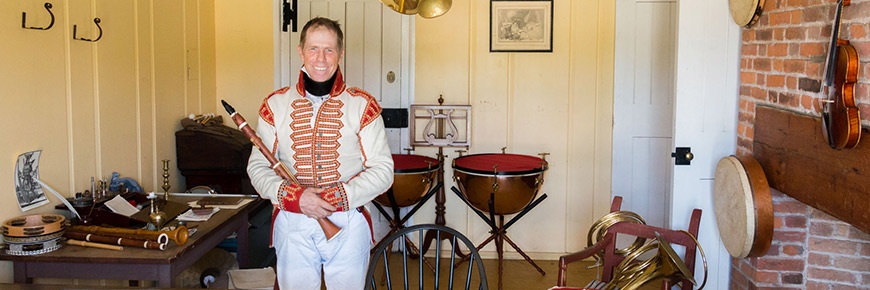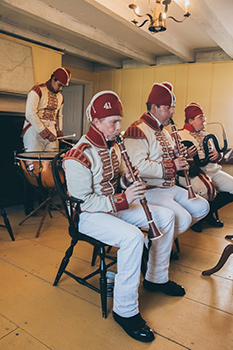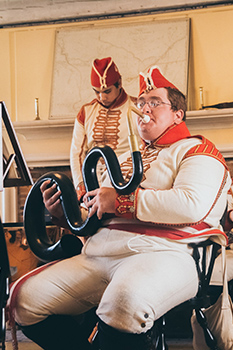
The 41st Band of Music at Fort George
Fort George National Historic Site
We are constantly uncovering more information and learning more about history. Recently, historic evidence on bands of music during the War of 1812 was unearthed and this evidence has been incorporated into the music program at Fort George National Historic Site. The 41st Band of Music at Fort George is the only band of its kind in Canada and was created to bring the sound of history to life!
History - Band of Music at Fort George during the War of 1812

Because of their stature in society and their personal wealth, officers sought out other forms of musical entertainment besides the drummers of the Fife and Drum Corps. Most officers had formal training in music and were capable of singing and performing on instruments, such as the violin. Even pianos were transported to Upper Canada. We know that several British regiments travelled to Fort George with band instruments. These instruments would have been used by the Band of Music created and financially supported by Officers, to play at ceremonies or for entertainment.
The bands could have been made up of officers, soldiers or civilian musicians. In the bands, professional civilian bandsmen were sometimes hired and equipped by the officers although they were very rarely found on the battlefield. The General Regulations and Orders for the Army in 1803 state that “In Regiments that have Bands of Music, one Private soldier of each Troop or Company is permitted to act as a Musician, and a Sergeant is allowed to act as Master of the Band; but all these Men are to be effective to the Service as Soldiers, are to be perfectly drilled, and liable to serve in the Ranks on any emergency."
Bands of Music in the early 1800s, played for the British Forces and for the local community. It was exciting to receive the latest music from Europe and to have the band perform and entertain the local upper class in the form of concerts, plays and dances. Bands of Music provided the best entertainment in the community and performances were an opportunity for local residents to be seen and do business. German music was popular as well as the nationalistic music of Britain and the latest dance music from Scotland.
The 49th regiment had a band of music and a set of instruments that were recorded as lost at the capture of Fort George in 1813. The collection included a serpent, bassoons and kettledrums, as well as more familiar instruments such as clarinets, flutes and brass instruments. This record provides evidence on the types of instruments that would have been played at Fort George prior to it’s capture by American forces.
The instruments

The Band of Music’s collection at Fort George includes a wide variety of historically accurate reproductions of instruments. The collection is comprised of flutes, clarinets, bassoons, violins, natural horns, trumpets, kettledrums, tambourines, triangles, cymbals, and a serpent, that all represent what would have been played by bands during the War of 1812.
Although some of these instruments may seem familiar, these are not the same instruments you would find in a modern orchestra. They were crafted very differently than instruments of today. For example, the flute the Band of Music plays is wooden with just a single key, whereas a modern flute is metal with tons of keys. The historic clarinets have the reeds tied to the mouthpiece with string rather than a modern metal attachment, they are wooden, with less keys, and have ivory or bone mounts, making them much different than modern clarinets. These reproductions of historic instruments are not as user friendly, but do offer a unique sound that carries you back in time.
There are also some instruments that are not as commonly seen today, for example the serpent. Aptly named for its snake-like shape, it is a bass instrument like the modern day tuba but made of wood and leather. It is in fact a medieval church instrument that historically would have helped the choir fill out their sound. By the 1800s, it was the deepest bass instrument you could have in your band.
When can you see the Band of Music?
The Band of Music is made of up talented and trained musicians who you can see in action this year at special events. You can also check out the collection of reproduction instruments on display in the Junior Officers Quarters at the fort.
For more information on Fort George’s Band of Music, please contact Peter Alexander at peter.alexander@pc.gc.ca.
- Date modified :